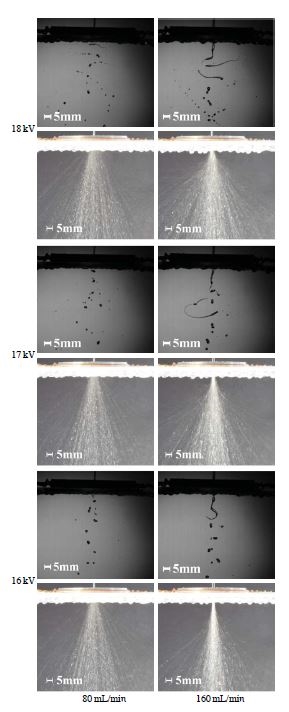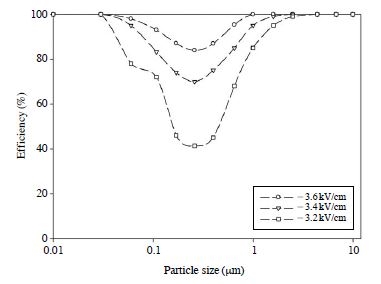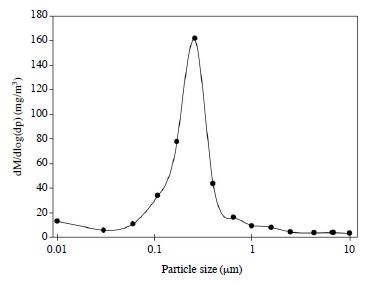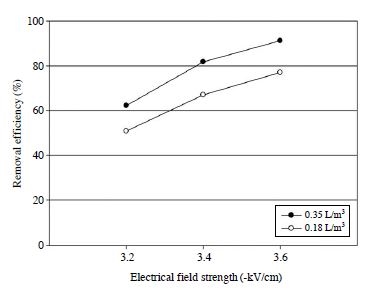
Experimental Study on the Enhancement of Particle Removal Efficiency in Spray Tower Scrubber Using Electrospray
Abstract
There have been a lot of efforts to keep permissible emission standards and to reduce the amount of emitted air pollutants. There are several air pollution control equipments, however, wet scrubber is used to remove particulate matters and gaseous pollutants simultaneously, even if it has low collection efficiency in the particle size less than 5.0 μm. To overcome this problem, we introduced a spray tower scrubber with an electrospray system which a high voltage was indirectly applied. We found that collection efficiency of fine particles in the electrospray system was improved by increasing electrical field strength and the ratio of liquid-gas flow rate (from 41% to 84% for 0.3 μm particles). In addition, a number of small droplets generated from an electrospray system led high collection efficiency, resulting from electrostatic attraction between droplets and particles and higher collision frequency. Therefore, we can conclude that the introduction of an electrospray system is quite effective to increase the particle removal efficiency of a spray tower scrubber.
Keywords:
Electrospray, Spray tower scrubber, Collection efficiency, Liquid-gas flow rate1. INTRODUCTION
Fine particles less than 2.5 μm are emitted from a power plant, an industrial boiler and other industrial facilities (Ehrlich et al., 2007). They are removed by rainout and washout rather than gravity sedimentation due to their physical properties, i.e. small size and low density (Wark et al., 1998; Hinds, 1982). However, fine particles can flow deep into the human body’s lungs, resulting in serious respiratory diseases. Especially, when they contain hazardous air pollutants such as heavy metals or polycylclic aromatic hydrocarbons, the negative effect can be larger (Oravisjarvi et al., 2014; Chow et al., 2010; Pacyna et al., 2010; Kim et al., 2008; Valavanidis et al., 2008). Furthermore, they can reduce visibility by scattering or absorbing visible light and can act as condensation nucleus causing unusual weather (Hobbs et al., 1993).
The criteria for particulate matters in Korea’s ambient air quality was established for the first time in 1983; TSP (total suspended particulate) criteria, having the annual average of 150 μg/m3, was strengthened to PM10 (particulate matter with an aerodynamic diameter less than 10 μm) with an annual average of 50 μg/m3 in 1995. The criteria of PM2.5 (<2.5 μm) is expected to have an annual average of 25 μg/m3 in 2015. Also, in order to meet the ambient air quality criteria, the regulations on emission source - permissible emission standard - are being strengthened. For example, a coal-fired power plant has an expectation of 20 mg/Sm3 in 2015 compared to the 30 mg/Sm3 in 2010. Therefore, to satisfy the constantly strengthening permissible emission standard, removal efficiency of an existing dust collector should be enhanced or a new precipitator with higher efficiency has to be installed instead of the existing precipitator in order to reduce the emission of air pollutants (Kim et al., 2012).
There are devices such as a bag house, an electrostatic precipitator, a scrubber, a centrifugal separator and others for controlling particulate matters. On the other hand, only a wet scrubber is effective to control gaseous pollutants or explosive dusts in a gas stream, however has a relatively low removal efficiency leading to the need of a solution to improve the efficiency. There are various wet scrubbers, i.e. spray tower typed, packed tower typed, vortex typed, and venturi typed scrubbers, applicable to industrial fields. A spray tower typed scrubber is generally introduced due to the effective removal of acid gaseous pollutants, even if it has relatively low removal efficiency in regard to fine particles (Cooper et al., 2002; Theodore and Buonicore, 1988). Therefore, this study is an experimental research that uses an electrospray system as a way to improve the scrubber’s removal efficiency of particles.
When conductive liquid is introduced through the nozzle and a high voltage is applied to the electrospray system, the ions within the nozzle and liquid move to the surface of the liquid due to the repulsive force and attraction force. When the applied voltage on the nozzle is not enough, droplets will not be emitted due to the electrostatic force acting upon the surface of the liquid and positive ions repulsion will be smaller than the surface tension. When the voltage is increased, the electrostatic force affects the surface of the liquid and positive ions repulsion becomes larger than the surface tension (Jaworek and Krupa, 1999). The spraying modes are classified into dripping mode, spindle mode, oscillating jet mode, precession mode and conejet mode. The cone-jet mode, which is the formation of a cone shaped edge of the meniscus, provides the most stable droplets generation in the entire modes. Liquid ligament thin as a thread is formed due to the surface tangential stress acting upon the end of the Taylor cone, and is divided into fine droplets at the end of the liquid ligament. This is because of the surface tangential stress that disturbs the surface of the liquid ligament (Bailey, 1998; Michelson, 1990). Electrosprayed droplets are quite monodisperse, highly charged and their size can be easily controlled by changing the flow rate and the electrical conductivity of the liquid (Ganan-Calvo et al., 1997). Such properties are used and applied to various fields such as the dispersion of pesticides, fuel injection, electrostatic painting, mass spectrometer analysis of biochemical materials, and so forth (Verdoold et al., 2014; Oliver, 2004).
However, the usage of an electrospray in an air pollution control system is still a study in process, and there are several studies about the application of charged droplets to scrubbers for the purpose of improving particle collection efficiency in an electrostatic precipitator (Carotenuto et al., 2010; Kim et al., 2010; Jaworek et al., 2006; Pilat et al., 1974). Implication of this study is to use the electrospray system as a way of improving the particle removal efficiency in a wet scrubber. The removal efficiency of fine particles in a spray tower scrubber with an electrospray system was measured and the images of droplets generated from the system were analyzed as a function of electrical field strength in this study.
2. EXPERIMENTAL
This study analyzed removal efficiencies of fine particles and observed images of electrosprayed droplets in a spray tower scrubber with an electrospray system. Experimental setup is illustrated in Fig. 1. The test system consisted of a particle generation system, an electrospray system, and measuring devices. To provide clean air into the test scrubber, a HEPA (High Efficiency Particulate Air) filter was installed. The scrubber was made of an acrylic column (column length; 600 mm, column diameter; 110 mm) and had a counter-current flow stream as seen in Fig. 1. Circular ring with 95 mm in diameter was installed to apply a high voltage at the distance of 50 mm away from the bottom of the nozzle with the inner diameter of 1.6 mm. A DC power supply (KSH-N30/5CD, Korea switching) with the capacity down to -30 kV was used.

Experimental setup to measure the particle removal efficiency in a spray tower scrubber with an electrospray system.
Test particles were generated using 1,1,3,3-tetramethyl disiloxane (TMDS, (CH3)2HSi-O-SiH(CH3)2, Aldrich). The impinger system with a TMDS solution was set in a water bath with constant temperature (0°C). Nitrogen gas (40 mL/min) was fed into the bottle containing TMDS. TMDS was vaporized by bubbling, then mixed with air (500 mL/min) before entering the tubular electric furnace (approximately 700°C). The gas to particle conversion of TMDS occurred in the electric furnace. Gas flows were controlled using mass flow controllers (Model 8300, Kofloc). As TMDS entered the electrical furnace in the form of vapors together with air, it rapidly turned into silicon oxides. The particle formation mechanisms are known as nucleation, condensation and coagulation (Kim et al., 2012; Lee et al., 2005). The size distribution and mass concentration of particles were measured with a 13-staged low pressure cascade impactor (DLPI, Dekati) coupled with an iso-kinetic sampler based on standard method ES 01112.1 in Korea. Applied voltage of the electrospray system was measured using a digital oscilloscope (TDS 2014B, Tektronix) and a high voltage probe (6101A, Tektronix). A resister of 10 kΩ was inserted into the ground line in series to measure the discharge current in the electrospray system. The gas velocity was measured using an anemometer (9515, TSI).
The removal efficiency (η) by an electrospray system was calculated by a following equation.
η=((concentration with electrospray system off-concentration with electrospray system on)/concentration with electrospray system off).
A measuring apparatus of electrosprayed droplets was shown in Fig. 2 and the spraying modes were observed by a high-speed camera (HHCX6BZ, Canadian Photonics Labs Inc.) and a DSLR camera (D5300, Nikon).
The specifications of the test electrospray scrubber in this study are shown in Table 1 along with those of a typical vertical spray tower (Theodore and Buonicore, 1998). In a vertical spray scrubber, gas velocity ranges typically from 0.6 to 1.8 m/sec. The average gas velocity in a test electrospray scrubber was 0.8 m/sec which is equivalent to a flow rate of 0.46 m3/min.
The ratio of liquid-gas flow rate (FL/FG) is calculated by dividing water flow rate by gas flow rate. When the water sprayed amounts are 80 and 160 mL/min, the ratios of liquid-gas flow rate are 0.18 and 0.35 L/m3, respectively.
The particle collection experiments were carried out under applied voltages of -16, -17, and -18 kV in an electrospray system. The electrical field strengths obtained from the relationship between the dimension and the applied voltages in the electrospray system were -3.2, -3.4, and -3.6 kV/cm, respectively.
3. RESULTS AND DISCUSSION
3. 1 Generation of Test Particles
The average concentration of test particles was about 90 mg/m3 and the particles are distributed log-normally (see Fig. 3). The peak value of fine particles was 0.2 μm and the particles in the size range of 0.1-1.0 μm occupied 74.5% of the total weight. Geometric mean and geometric standard deviation were 0.2 μm, 2.4 respectively. This size range corresponds to the most penetrating particle size in the scrubber and in most other precipitators as well (Ehrlich et al., 2007; Peukert et al., 2001; Theodore and Buonicore, 1988). Therefore, it is deemed to be the optimum size range of particles for the spray tower scrubber experiment for this study (Kim et al., 2012).
3. 2 Characteristics of Voltage-current and Images of Sprayed Droplets from the Electrospray System
Fig. 4 shows the current-voltage relationship at FL/FG ratio of 0.18 and 0.35 L/m3 in the electrospray system. The electric current linearly increased with applied voltage and drastically increased from -13 kV. When a voltage of -19 kV (liquid flow rate, 160 mL/min) was applied, a current of 92 μA was measured. However, an electric spark was generated at applied voltage even higher. The measured current was proportional to the water feeding rate. This is a phenomenon normally found in negative polarity corona (Kim et al., 2011).
Fig. 5 shows the images of the water electrosprayed droplet at different applied voltages and different liquid flow rate taken with a high-speed camera and DSLR camera. Although the droplet size could not be measured accurately, the water droplet size decreased with increasing applied voltage to the electrospray system. The ratio of small droplets also increased with applied voltage. We can also observe that the number of droplets increased with increasing liquid flow rate.

Images of electrosprayed droplets taken with a high-speed camera and a DSLR camera (The speed of high-speed camera; 4,000 frames/sec, The exposure time of DSLR camera; 1 sec).
A number of studies on electrospray revealed that the parameters which affect the droplet size were the liquid’s viscosity, conductivity, liquid flow rate, spray current, applied voltage and so forth (Verdoold et al., 2014; Hartman et al., 2000; Ganan-Calvo et al., 1997). This study also revealed the same results as previous studies.
3. 3 Evaluation of Particle Removal Efficiency
The collection efficiency corresponding to the change of electrical field strength and FL/FG ratio is shown in Fig. 6. When FL/FG ratio was 0.18 L/m3 and the electrical field strengths were -3.2, -3.4, -3.6 kV/cm, the particle removal efficiencies were measured as 50.8%, 67.0%, 77.1% respectively. When FL/FG ratio was 0.35 L/m3 and the electrical field strengths were -3.2, -3.4, -3.6 kV/cm, the particle removal efficiencies were measured as 62.2%, 81.7%, 91.2%, respectively.
We can see that particle removal efficiency increased with increasing electrical field strength at the same ratio of liquid-gas flow rate and with increasing FL/FG ratio at the same electrical field strength.
Fig. 7 shows the fractional collection efficiency as a function of electrical field strength at the fixed FL/FG ratio of 0.35 L/m3. The most penetrating particle size was in the range of 0.1-0.7 μm. Especially, the collection efficiency of 0.3 μm particles was quite low being about 41% at the electrical field strength of -3.2 kV/cm. However, it was improved to 84% at the electrical field strength of -3.6 kV/cm. This is considered as electrospray effect.

Fractional collection efficiency of the scrubber with an electrospray system as a function of particle diameter.
Therefore, enhancement of collection efficiency by using electrospray system in a spray tower scrubber is expected to meet the tightened permissible emission standards to a certain extent.
3. 4 Effects of Electrospray
In general, the scrubber’s collection efficiency depends on particle size. Diffusion is a dominant collection mechanism for particles less than 0.05 μm. However, impaction, interception as well as diffusion should be considered as collection mechanisms of particles in the range of 0.05-1.0 μm and inertial impaction is dominant for particles bigger than 1 μm (Carotenuto et al., 2010; Lim et al., 2006; Kim et al., 2001). As shown in Fig. 3, the particle size used in this study was around 0.1-2.0 μm; therefore, removal mechanisms such as diffusion, impaction, interception seem to be effective. Collection efficiency due to diffusion is high at small sized droplets, low relative velocity between droplets and particles, and high number concentration. The collection efficiency due to inertial impaction depends on the Stokes number which represents inertial force, and increased with increasing droplet size and relative velocity. Collection efficiency due to interception increases with decreasing droplet size and increasing number concentration (Lim et al., 2006; Jung et al., 1998).
We could see that the droplet size decreased with increasing applied voltage in the electrospray system, and hence the number concentration of droplets increased since water flow rate was constant. This is the reason of increasing collection efficiency in the electrospray system.
Furthermore, the highly charged droplets can easily attract particles, resulting in electrical agglomeration between particles and droplets. This is considered as another reason to increase particle removal efficiency.
4. CONCLUSIONS
The electrospray system was installed to enhance particle collection efficiency of the spray tower scrubber in this study. Particle removal efficiency was measured at various electrical field strengths and the ratios of liquid-gas flow rate. The results are shown below.
- 1. Collection efficiency of fine particles in the electrospray system was improved by increasing electrical field strength and the ratio of liquid-gas flow rate.
- 2. A number of small droplets generated from an electrospray system lead high collection efficiency, resulting from electrostatic attraction between droplets and particles and higher collision frequency.
- 3. From these results, it is possible to meet the tightened permissible emission standards of particulate matters even with a small investment amount which installs the electrospray system on existing spray tower scrubbers.
References
-
Bailey, A.G., (1998), Electrostatic spraying of liquids, Jhon Wiley & Sons Inc., p60-75.
[https://doi.org/10.1088/0031-9112/35/4/018]

-
Carotenuto, C., Natale, F.D., Lancia, A., (2010), Wet electrostatic scrubbers for the abatement of submicronic particulate, Chemical Engineering Journal, 165, p35-45.
[https://doi.org/10.1016/j.cej.2010.08.049]

-
Chow, J.C., Watson, J.G., Lowenthal, D.H., Chen, L.-W.A., Motallebi, N., (2010), Black and organic carbon emission inventories: Review and Application to California, Journal of the Air & Waste Management Association, 60, p497-507.
[https://doi.org/10.3155/1047-3289.60.4.497]

- Cooper, C.D., Alley F.C., , (2002), Air pollution control; A design approach, Waveland Press, Inc., p209-217.
-
Ehrlich, C., Noll, G., Kalkoff, W.-D., Baumbach, G., Dreiseidler, A., (2007), PM10, PM2.5 and PM1.0-Emissions from industrial plants-Results from measurement programmes in Germany, Atmospheric Environment, 41, p6236-6254.
[https://doi.org/10.1016/j.atmosenv.2007.03.059]

- Ganan-Calvo, A.M., Davila, J., Barrero, A., (1997), Current and Droplet size in the Electrospraying of Liquids. Scaling laws, Journal of Aerosol Science, 28(2), p249-275.
- Hartman, R.P.A., Brunner, D.J., Camelot, D.M.A., Marijnissen, J.C., Scarlett, B., (2000), Jet break-up in electrohydrodynamic atomization in cone jet mode, Journal of Aerosol Science, 31(1), p65-95.
- Hinds, W.C., (1999), Aerosol Technology, John Wiley & Sons, Inc., p304-314.
- Hobbs, P.V., (1993), Aerosol-Cloud-Climate Interaction, Academic Press, Inc., p75-93.
-
Jaworek, A., Balachandran, W., Lackowki, M., Kulon, J., Krupa, A., (2006), Multi-nozzle electrospray system for gas cleaning processes, Journal of Electrostatics, 64, p194-202.
[https://doi.org/10.1016/j.elstat.2005.05.006]

-
Jaworek, A., Krupa, A., (1999), Classification of the Modes of EHD spraying, Journal of Aerosol Science, 30(7), p873-893.
[https://doi.org/10.1016/s0021-8502(98)00058-5]

-
Jung, C.H., Lee, K.W., (1998), Filtration of fine particles by multiple liquid droplet and gas bubble system, Aerosol Science and Technology, 29(5), p389-401.
[https://doi.org/10.1080/02786829808965578]

-
Kim, H.H., Kim, J.H., Ogata, A., (2011), Time-resolved high-speed camera observation of electrospray, Journal of Aerosol Science, 42, p249-263.
[https://doi.org/10.1016/j.jaerosci.2011.01.007]

-
Kim, H.T., Jung, C.H., Oh, S.N., Lee, K.W., (2001), Particle removal efficiency of gravitational wet scrubber considering diffusion, interception, and impaction, Environmental Engineering Science, 18(2), p125-136.
[https://doi.org/10.1089/10928750151132357]

-
Kim, J.H., Lee, H.S., Kim, H.H., Ogata, A., (2010), Electrospray with electrostatic precipitator enhances fine particles collection efficiency, Journal of Electrostatics, 68, p305-310.
[https://doi.org/10.1016/j.elstat.2010.03.002]

- Kim, J.H., Yoo, H.J., Hwang, Y.S., Kim, H.G., (2012), Removal of particulate matter in a tubular wet electrostatic precipitator using a water collection electrode, The Scientific World Journal, 532354.
-
Kim, K.-H., Hong, Y.-J., Pal, R., Jeon, E.C., Koo, Y.-S., Sunwoo, Y., (2008), Investigation of carbonyl compounds in air from various industrial emission sources, Chemosphere, 70(5), p807-820.
[https://doi.org/10.1016/j.chemosphere.2007.07.025]

-
Lee, M.H., Cho, K., Shah, A.P., Biswas, P., (2005), Nanostructured sorbents for capture of cadmium species in combustion environments, Environmental Science & Technology, 39, p8481-8489.
[https://doi.org/10.1021/es0506713]

-
Lim, K.S., Lee, S.H., Park, H.S., (2006), Prediction for particle removal efficiency of a reverse jet scrubber, Journal of Aerosol Science, 37, p1826-1839.
[https://doi.org/10.1016/j.jaerosci.2006.06.010]

- Michelson, D., (1990), Electrostatic Atomization, IOP Publishing Ltd, p82-91.
- Oiliver, W., (2004), Electrohydrodynamic spraying - Transport, mass and heat transfer of charged droplets and their application to the deposition of thin functional films, PhD thesis, University of Tubingen, The Swiss.
- Oravisjarvi, K., Pietikainen, M., Ruuskanen, J., Niemi, S., Lauren, M., Voutilainen, A., Keiski, R.L., Rautio, A., (2014), Diesel particle composition after exhaust aftertreatment of an off-road diesel engine and modeling of deposition into the human lung, Journal of Aerosol Science, 69, p32-47.
-
Pacyna, J.M., Sundseth, K., Pacyna, E.G., Jozewicz, W., Munthe, J., Belhaj, M., Astrom, S., (2010), An assessment of costs and benefits associated with mercury emission reductions from major anthropogenic sources, Journal of the Air & Waste Management Association, 60, p302-315.
[https://doi.org/10.3155/1047-3289.60.3.302]

-
Peukert, W., Wadenpohl, C., (2001), Industrial separation of fine particles with difficult dust properties, Powder Technology, 118, p136-148.
[https://doi.org/10.1016/s0032-5910(01)00304-7]

- Pilat, M.J., Jaasund, S.A., Sparks, L.E., (1974), Collection of aerosol particles by electrostatic droplet spray scrubbers, Environmental Science & Technology, 6, p360-362.
- Theodore, L., Buonicore, A.J., (1988), Air pollution control equipment, CRC press, Inc., p232-237.
-
Valavanidis, A., Fiotakis, K., Vlachogianni, T., (2008), Airborne particulate matter and human health : Toxicological assessment and importance of size and composition of particles for oxidative damage and carcinogenic mechanisms, Journal of Environmental Science and Health Part C, 26, p339-362.
[https://doi.org/10.1080/10590500802494538]

-
Verdoold, S., Agostinho, L.L.F., Yurteri, C.U., Marijnissen, J.C.M., (2014), A generic electrospray classification, Journal of Aerosol Science, 67, p87-103.
[https://doi.org/10.1016/j.jaerosci.2013.09.008]

- Wark, K., Warner, C.F., Davis, W.T., (1998), Air pollution Its origin and Control, Addison Wesley Longman Inc., p188-191.




